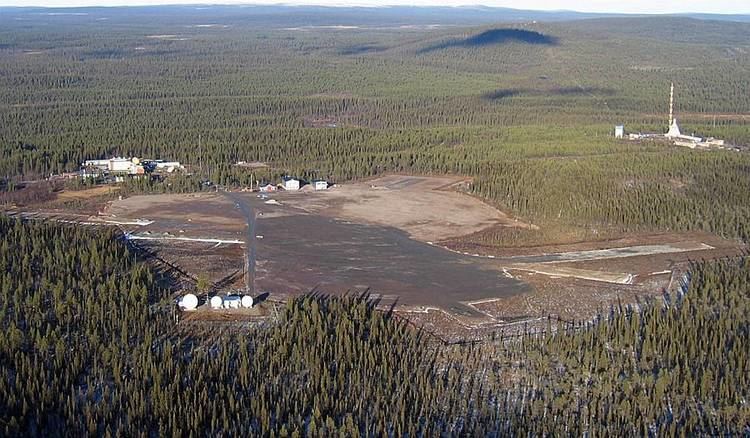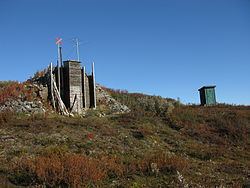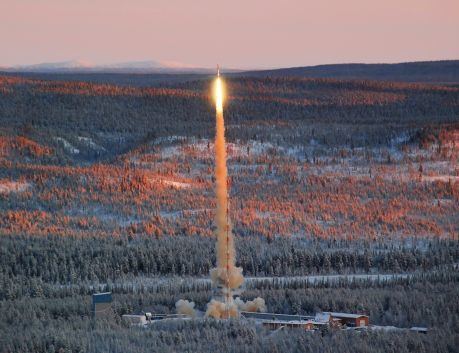 | ||
Launch of texus 53 from esrange space center
Esrange Space Center (short form Esrange) is a rocket range and research centre located outside the town of Kiruna in northern Sweden. It is a base for scientific research with high-altitude balloons, investigation of the aurora borealis, sounding rocket launches, and satellite tracking, among other things. Located 200 km north of the Arctic Circle and surrounded by a vast wilderness, its geographic location is ideal for many of these purposes.
Contents
- Launch of texus 53 from esrange space center
- Esrange space center den svenska rymdbasen med internationell verksamhet
- History
- Name
- Rocket activities
- Balloon activities
- Satellite services
- Satellite control services
- Ground station services
- References

Esrange was built in 1964 by ESRO, the European Space Research Organisation, which later became European Space Agency by merging with ELDO, the European Launcher Development Organisation. The first rocket launch from Esrange occurred on 19 November 1966. In 1972, ownership was transferred to the newly started Swedish Space Corporation.

Esrange space center den svenska rymdbasen med internationell verksamhet
History

In the 1960s ESRANGE was established as an ESRO sounding rocket launching range located in Kiruna (Sweden). This location was chosen because it was generally agreed that it was important to carry out a sounding rocket programme in the auroral zone, and for this reason it was essential that ESRO equip itself with a suitable range in the northern latitudes. Access to Kiruna was good by air, road and rail, and the launching range was relatively close to the town of Kiruna. Finally and perhaps decisively, ESRANGE could be located near Kiruna Geophysical Observatory (subsequently renamed to Swedish Institute of Space Physics). In 1972 ownership and operations of the range was transferred to the Swedish Space Corporation.
Name
The name of the facility was originally ESRANGE, which was an abbreviation for ESRO Sounding Rocket Launching Range.
When Swedish Space Corporation took over the range, Esrange (with capital 'E' only) became a name only.
Esrange Space Center is the name that is currently used for the facility.
Rocket activities

There had been Swedish rocket activities previously, mainly at Kronogård (18 launches in the period 1961-1964). However, the rocket activity in Sweden did not gain thrust until after ESRO established Esrange in 1964.

During the period 1966-1972 ESRO launched more than 150 rockets from Esrange. Most of these were Centaure, Nike Apache, and Skua rockets reaching 100–220 km altitude. They supported many branches of European research, but the emphasis was on atmospheric and ionospheric research.

In 1972 the management of Esrange was transferred to the Swedish Space Corporation (SSC). Gradually the smaller rockets were complemented by larger rockets reaching higher altitudes, achieving weightlessness for a few minutes when the rocket is above the parts of the atmosphere giving an appreciable friction. Three main programmes, Texus, Maser, and Maxus currently dominate the rocket activities at Esrange and support microgravity research for ESA and DLR:
More than 500 rockets have been launched from Esrange since 1966. For information on individual rockets, see the List of rockets launched from Esrange.
Esrange has six launchers:
Balloon activities
Since 1974, more than 500 high-altitude balloons have been launched from Esrange for research purposes. The launch pad can handle balloons with volumes exceeding 1 million cubic meters.
Satellite services
The arctic latitude of Esrange makes it very suitable for communication with satellites in polar orbits. Satellite services began in 1978.
Satellite control services
A number of telecommunication satellites have been controlled through Esrange:
Most research satellites of the Swedish space programme have received control commands through Esrange:
The exception was controlled from SSC's laboratories in Solna outside Stockholm:
Ground station services
Data have been received at Esrange from more than 50 satellites, including SPOT 1-5, Landsat 2-7, ERS 1-2 and Envisat.
